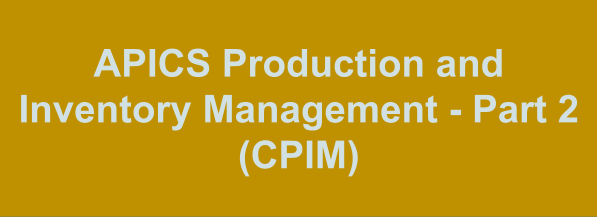Certified in Planning and Inventory Management (CPIM 7.0)
Resilience and agility are what make supply chains thrive in today’s rapidly changing world. Becoming CPIM certified shows employers that you know how to effectively manage disruptions, demand variations and supply chain risk.
Why Seek the CPIM Designation?
The pandemic caused a major shift in consumer demand and put a spotlight on supply chain vulnerabilities. Planning is now more important than ever, and the new Certified in Planning and Inventory Management (CPIM) 7.0 reflects that.
With a CPIM certification, you will develop the competencies they need to successfully work across all functions of the supply chain. In addition, you'll have the knowledge to better respond to supply disruptions, demand variations, and manage supply chain risk.
CPIM Certification, by Industry
APICS CPIMs work across a broad range of professions including:
◉ Manufacturing
◉ Consulting
◉ Education
◉ Government
◉ Services
◉ Defense
◉ Healthcare
◉ Distribution
◉ Pharmaceutical
APICS Production and Inventory Management - Part 2 (CPIM)
APICS CPIM Part 2 Exam Summary:
| Exam Name | APICS Production and Inventory Management - Part 2 |
| Exam Code | CPIM Part 2 |
| PLUS member Exam Fee | USD $495 |
| CORE member/nonmember Exam Fee | USD $690 |
| Retake Exam Fee | USD $250 |
| Exam Duration | 210 Minutes |
| Number of Questions | 150 |
| Passing Score | 300 / 350 |
| Format | Multiple Choice Questions |
| Sample Questions | APICS CPIM 7.0 P2 Exam Sample Questions and Answers |
| Practice Exam | APICS Certified in Production and Inventory Management (CPIM Part 2) Practice Test |
APICS Production and Inventory Management - Part 2 Syllabus Topics:
| Topic | Details | Weights |
| Align the Supply Chain to Support the Business Strategy | - Understand the business environment and develop corporate strategy - Develop, align, and implement functional and operational strategies - Design processes and layouts to align with strategic goals - Define and monitor key performance indicators (KPIs) to evaluate performance in relation to the organization’s strategic goals - Identify and manage supply chain risks (examples include: supply disruption, financial, environmental, physical, political, cyber, intellectual property, and branding) - Manage capital equipment and facilities - Define and support sustainability goals (environmental, financial, social) |
22% |
| Conduct Sales and Operations Planning (S&OP) to Support Strategy | - Understand the role of the S&OP process in the organization - Review aggregate demand plan - Review aggregate supply plan - Reconcile portfolio, demand, supply, and financial plans |
10% |
| Plan and Manage Demand | - Determine customer needs and specifications - Understand marketing and product management considerations - Review sources of demand - Generate demand forecast - Monitor forecast performance and respond to demand variation or changes |
9% |
| Plan and Manage Supply |
- Create the master schedule |
16% |
| Plan and Manage Inventory |
- Inventory planning |
14% |
| Plan, Manage, and Execute Detailed Schedules | - Plan detailed schedules - Create production schedules - Implement and manage detailed schedules - Schedule incoming materials |
12% |
| Plan and Manage Distribution | - Plan distribution - Manage customer orders - Manage reverse logistics |
3% |
| Manage Quality, Continuous Improvement, and Technology | - Manage quality - Manage continuous improvement - Manage technology |
14% |





0 comments:
Post a Comment